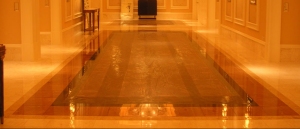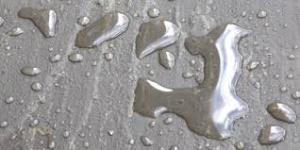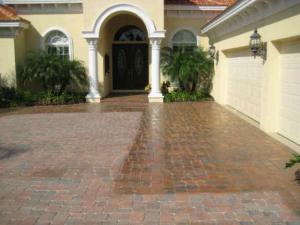Natural stone floors and counter tops continue to get more and more popular each year and it’s no wonder why. Not only does natural stone give your home a timeless classic look, but natural stone is durable and adds value to your home. However, if you do not know how to properly care for your natural stone, you can end up spending more time and money being frustrated with stains and repairs instead of enjoying the beautiful addition to your home.
Sealing your natural stone or ceramic tile surfaces is crucial in preserving it’s appearance and protecting it from everyday stains that can occur. Sealer is necessary for protection because natural stone surfaces are porous and absorb spills and oily soils. Once the soils have penetrated your natural stone and been absorbed, it can become extremely difficult to clean and remove. As we all know, accidents do happen which is where sealer comes in to save the day.
Sealer fills the pores with a clear impregnating sealer that will not change the appearance of the surface, but will allow you to quickly clean up the surface and prevent it from becoming permanently stained, etched, and damaged. Most sealers will last a few years if properly maintained, but will eventually break down and should be reapplied periodically.
As important as sealing your natural stone surfaces is, it is equally as important to use the proper cleaning products. Many common cleaning products that contain ammonia, bleach, or acidic ingredients will prematurely degrade your sealer and damage your surfaces. A common misconception about cleaning stone is that “natural cleaners” can be better for your natural stone. This could not be further from the truth. Natural cleaners often contain ingredients like lemon juice and vinegar which are acidic ingredients that will also prematurely degrade and damage your surfaces.
The key to finding acceptable cleaning products for your surfaces is to look at the ingredients and read the label entirely. A “neutral PH” tile or stone cleaning product is always acceptable and best to use. The PH scale runs from 1 to 14. The lower numbers on the PH scale indicate highly acidic compounds. The higher numbers on the PH scale indicate highly alkaline compounds such as bleach. A “neutral cleaner” will mean its a “7” on the PH scale. Most specialty cleaners will have the PH noted on the label and can be found at most home centers or can be purchased online.
Whether you need your recently installed natural stone surfaces sealed for the first time, or you need your existing surfaces cleaned and re-sealed, we are here for you. Call Fuller Stone Care at 310-944-9099 today to get all your questions answered and set up a free estimate.
Warning about stone care products: “Do research first,” cautions Larry Fuller, a 20 year veteran stone care expert and founder of Fuller Stone Care. Many household cleaning products can damage marble or other natural stone, which can lead to unnecessary restoration cost.
Larry says that lots of these cleaning product companies make claims that are misleading or they make promises claiming that their product will remove stains, water marks or reduce dullness and scratching.
If you check our website; fullerstonecare.com, we offer many tips and tricks to maintain your investment and to prevent restoration cost.
If you have just purchased a new stone floor, Larry advises homeowners to make sure the marble or whatever type of natural stone is sealed upon installation. It’s not uncommon for a new natural stone installation to be installed without a protective seal, leaving it immediately vulnerable to stains and etches. After installation, plan a regular routine of daily cleaning which we have clearly outlined for you in: http://marblecleaninghermosabeach.com/southbay/. We also previously wrote an article about how to test your floors sealant in our blog. Redoing a Previously Sealed Surface
An example of poor maintenance: to apply multiple coats of wax. What a mess! As the coatings build up it becomes soft, and dirt is easily embedded in the soft layer. These coatings require frequent stripping which is often neglected, but the best maintenance you can do.
A great idea is to have Fuller Stone Care maintain your natural stone floors on a regular basis. In the meantime, use our specially designed product “Natural Stone Cleaner and Conditioner” and continue to maintain your investment for perfection.
Terrazzo restoration is in fact an easy procedure which requires a little bit of care and the knowledge of quality maintenance. Terrazzo is actually a compound of marble chips and concrete or epoxy. To know the ingredients of the terrazzo floor, you have to first figure out its best course of action. It will decide the things you must use to dapple cracks or holes (repair) which you can see and the products that are safe for clearing this kind of floor.
A proper cleaning of the floor with slightly hot water to extract the dirt is a good idea after repairs. With a clean & repaired floor, polish the terrazzo. After which the terrazzo can be cleaned without any chemical products. If you want to cover the holes of your floor, an expert worker of marble polishing and terrazzo can get the job done. The polishing of terrazzo without using chemical cleaners is a much more healthy way of living.
The polishing process of terrazzo includes grinding of a thin layer on the floor. This extracts any stained terrazzo from its surface and produces a lustrous layer. The patches will not go even after polishing the terrazzo, but floor will be shining. The Terrazzo restoration process will make the floor look much more beautiful. After this the terrazzo may last your entire life if maintained with proper care.
Maintenance is a must for terrazzo. When you first install terrazzo it is beautiful. Then it’s up to you to maintain that beauty with proper care. You can initially start with washing or sweeping the floor a couple of times a week. It’s a good idea to have Fuller Stone Care apply sealer which will protect the terrazzo from getting stained.
You may even opt for a professional cleaning service like Fuller Stone Care to take care of your investment. You can enjoy these beautiful floors forever if they are maintained properly. If you have a sufficient budget, opt for Fuller Stone Care, a professional service, to maintain your terrazzo floors.
Since marble is a calcite-based stone it will etch very easily and appear to have dull spots as a result of most spills. These marks will typically become noticeable in a “heavily used ” area, such as a kitchen or bathroom. An etch-mark is an abrasion on the surface that will appear dull and may sometimes be slightly rough to-the-touch. Fuller Stone Care can restore the original sheen through restoration. Fuller Stone Care also helps to educate you on proper daily cleaning methods and products, as well as spill cleanup solutions.
Not only does marble start to lose its sheen, it may even discolor. Foot-traffic and constant abrasion in your common areas will contribute to this. At this time professional refinishing (restoration) will be necessary. This is another task for the professional to take on, usually with a wet and dust-free process call Diamond Grinding or Diamond Honing.
Sealing your marble is also very helpful in the fight against stains. A stain is an acute discoloration left behind after a product or liquid penetrated the surface. They are stubborn and at times impossible to get out. Fuller Stone Care can offer you solutions for stain-removal.
Redoing a Previously Sealed Surface!
If the surface has been sealed in the past, then the assumption is that the floor is not the same as when it was first installed. However, a previously sealed stone floor can be redone.
You are no longer considering sealing a “mexican tile floor”, a “brick” floor, a “flagstone” floor. It is now flooring that might contains a sealer which creates different absorption characteristics.
Stripping only removes sealer to the surface, not what is below the surface. Therefore, the stripped surface must be considered, because the floor may potentially still be partially sealed.
The job of a sealer is to “repel” things. This can include a new sealer. If the bond between sealers is not good, the result may be some degree of separation of the two sealers, i.e. peeling or cracking.
How to Test For The Surface Absorption Rate! (This is a rough guideline but will be very helpful) Use this test to:
- Determine if that new surfacing has different characteristics than expected.
- Determine if a sealer (or oil, or wax) has been used, and how much is remaining below the surface.
- Determine absorption range to enable good decision making regarding the desired sealer’s solids level. This will make sense in a few minutes as you proceed.
- Determine if there is any cracking, or peeling on the surface of the stone.
Using an eye dropper or drinking straw – randomly apply water drops to a few of the surface pieces. Don’t forget to include the grout joints in your considerations. You will be looking for the surface to darken to some degree as an indication of water absorption.
This guideline of approximate rates refers to absorption of 90% or more of a water drop within the time stated. Below are moving pictures that give an approximation of what you will see.
If the surface absorbs:
- Absorbs in 2 seconds or less … high absorbtion.
- Absorbs in 3 to 15 seconds ……. medium absorbtion.
- Absorbs in 16 to 60 seconds …. low absorbtion
- Absorbs in 1 to 3 minutes ………. very low absorbtion
- Does not absorb in 15 minutes .. caution. This may be difficult to seal
- Absorbs at noticeably different rates in various places
- There may something in the surface to impede sealer penetration, or it may have been sealed before without your knowledge. That sealing could have been done by the surfacing manufacturer, the selling store, or by the installer. This situation needs to be handled differently.
The stone absorption rate will probably be somewhere in between these high and low examples. Call your stone care professional today. Fuller Stone Care professionally removes sealer and restores your floor to once again look amazing.
Fuller Stone Care can professionally identify and solve tile and grout issues such as dirty grout, grout haze, improper sealing, inconsistent grout color and mildew stains. We can also help you change the look of your floor without having to incur the cost and mess of tearing up your old tile or stone floor. This process can be as simple as coloring your grout or utilizing an enhancing sealer on your natural stone. These processes also help extend the life of your grout or stone floor.
For further information:
Fuller Stone Care Sealing
And what to do about them…
Marble, granite, limestone and other decorative stone are durable materials that will last a lifetime. However, if the stone is installed incorrectly or not cared for properly, problems may result that will shorten its life.
THE FOLLOWING ARE THE MOST COMMON PROBLEMS THAT MAY OCCUR
1. Loss of shine
The loss of the high polish on certain marble and granite can be attributed to wear. This is especially true of marble, since it is much softer then granite. When shoes track in dirt and sand, the bottoms of the shoes can act like sandpaper on a stone floor surface and over time will wear the polish off. Fuller Stone Care a restoration professional can restore the polish.
2. Etching
The dull, whitish spot created when liquids containing acids are spilled on marble is called etching. Marble and limestone etch very easily. Granite is very acid-resistant and will rarely etch. To prevent etching, avoid using cleaners and chemicals that contain acids. Light etching can be removed with a little marble polishing powder. Deep etching or large areas will require the services of a restoration professional.
3. Stains
Some stone surfaces can become stained easily if they are not properly sealed. Many foods, drinks, ink, oil and rust can cause stains. Most stains on stone can be removed with professional cleaning. For some, more difficult stains, professional techniques by a stone restoration provider may be the only hope. Permanent stains can occur but not often.
4. Efflorescence
Efflorescence appears as a white powdery residue on the surface of the stone. It is a common condition on new stone installations or when the stone is exposed to a large quantity of water, such as flooding. This powder is a mineral salt from the setting bed. To remove efflorescence do not use water. Buff the stone with a clean polishing pad or #0000 steel wool pad. The stone will continue to effloresce until it is completely dry. This drying process can take several days to as long as one year. Do not seal the stone until any efflorescence is gone.
5. Spalling, Flaking and Pitting
If your stone is developing small pits or small pieces of stone are popping off the surface (spalling) then you have a problem. This condition is common on stone exposed to large amounts of water or when deicing salts are used for ice removal. Like efflorescence, mineral salts are the cause for spalling and pitting. Instead of the salts depositing on the surface (efflorescence) they deposit below the surface of the stone, causing pressure within the stone, causing stone spalls, flakes or pits. Unfortunately, once a stone begins to spall it is almost impossible to repair. It is recommended that the stone be replaced.
6. Yellowing
There are several reasons why a stone will turn yellow: Embedded dirt and grime can give the stone a yellow, dingy look. Waxes and other coatings can yellow with age. Certain stones will naturally yellow with age as a result of oxidation of the iron within the stone. This is especially problematic with white marbles. If the yellowing is caused by dirt or wax build up, have the stone cleaned with an alkaline cleaner or wax stripper. This may be a job best left to professionals. If the yellowing is the result of aged stone or iron oxidation, it is not coming out.
7. Uneven Tile (Lippage)
Lippage is the term given to tiles that are set unevenly. In other words, the edge of one tile is higher than the next and is the result of a poor installation. If the lippage is higher than the thickness of a nickel, it is considered excessive and the tile will have to be ground by a restoration contractor to flatten the floor.
8. Cracks and Chips
Cracks in stone can be caused by settling, poor installation, inadequate underlying support or excessive vibration. Chips can result from a bad installation or when a heavy object falls on a vulnerable corner. Repairs can be done by a professional stone restoration contractor by filling with a color matched polyester or epoxy.
9. White Stun Marks
Stun marks appear as white marks on the surface of the stone and are common in certain types of marble. These stuns are the result of tiny explosions inside the crystal of the stone. Pin point pressures placed on the marble cause these marks. Women’s high heels or blunt pointed instruments are common reasons for stun marks. Stun marks can be difficult to remove. Grinding and/or polish honing can reduce the number of stuns, but some travel through the entire thickness of the stone.
10. Water Rings/Spots
Water rings and spots are very common on marble and other natural stone surfaces. They are either areas that have become etched or are from hard water minerals such as calcium and magnesium that are left behind when water evaporates, leaving a ring or a spot. To remove either type of these spots, use a marble polishing powder. Moderate to severe etching or larger damaged areas will require professional honing by a stone restoration contractor. Namely, Fuller Stone Care and Restoration.
Travertine is also versatile; many homes use it in kitchens, bathrooms, living quarters, and outside. Sink counters, floors, tub surrounds, and showers are all examples of ways travertine can be used indoors. Outdoor uses include decks and patios, driveways, and pool surrounds.
Sleek fireplace with Travertine. The floor would look so much better with a dark wood rather than carpet. Travertine can be more expensive but the look is unique. It just depends on the individuals style. Each type of stone has it’s own warmth, tone, and personality.














